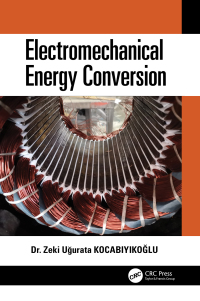Buy Electromechanical Energy Conversion 1st Edition PDF ebook by author Zeki U?urata Kocabiyiko?lu – published by CRC Press in 2021 and save up to 80% compared to the print version of this textbook. With PDF version of this textbook, not only save you money, you can also highlight, add text, underline add post-it notes, bookmarks to pages, instantly search for the major terms or chapter titles, etc.
You can search our site for other versions of the Electromechanical Energy Conversion 1st Edition PDF ebook. You can also search for others PDF ebooks from publisher CRC Press, as well as from your favorite authors. We have thousands of online textbooks and course materials (mostly in PDF) that you can download immediately after purchase.
Note: e-textBooks do not come with access codes, CDs/DVDs, workbooks, and other supplemental items.
eBook Details:
Full title: Electromechanical Energy Conversion 1st Edition
Edition: 1st
Copyright year: 2021
Publisher: CRC Press
Author: Zeki U?urata Kocabiyiko?lu
ISBN: 9780367524029, 9780128187364
Format: PDF
Description of Electromechanical Energy Conversion 1st Edition:
Direct Liquid Fuel Cells is a comprehensive overview of the fundamentals and specificities of the use of methanol, ethanol, glycerol, formic acid and formate, dimethyl ether, borohydride, hydrazine and other promising liquid fuels in fuel cells. Each chapter covers a different liquid fuel-based fuel cell such as: Anode catalysts of direct methanol fuel cells (DMFCs), future system designs and future trends for direct ethanol fuel cells (DEFCs), development of catalysts for direct glycerol fuel cells (DGFCs), the mechanisms of the reactions taking place at the anode and cathode electrodes, and the reported anode catalysts for direct formic acid fuel cell (DFAFC) and direct formate fuel cell (DFFC), characteristics of direct dimethyl ether fuel cell (DDMEFC), including its electrochemical and operating systems and design, the developments in direct borohydride fuel cells, the development of catalysts for direct hydrazine fuel cells (DHFCs), and also the uncommonly used liquids that have a potential for fuel cell applications including 2-propanol, ethylene glycol, ascorbic acid and ascorbate studied in the literature as well as utilization of some blended fuels. In each part, the most recent literature is reviewed and the state of the art is presented. It also includes examples of practical problems with solutions and a summarized comparison of performance, advantages, and limitations of each type of fuel cell discussed. Direct Liquid Fuel Cells is not a typical textbook but rather designed as a reference book of which any level of students (undergraduate or graduate), instructors, field specialists, industry and general audience, who benefit from current and complete understanding of the many aspects involved in the development and operation of these types of fuel cells, could make use of any chapter when necessary.Presents information on different types of direct liquid fuel cells.Explores information under each section, for specific fuel-based fuel cells in more detail in terms of the materials used.Covers three main sections: direct alcohol, organic fuel-based and inorganic fuel-based fuel cells





